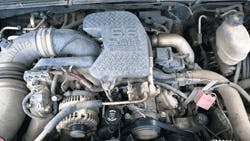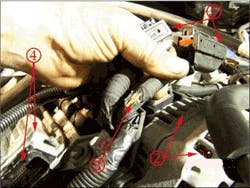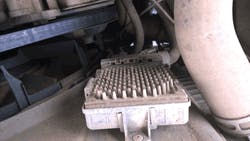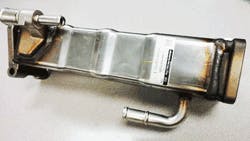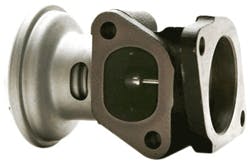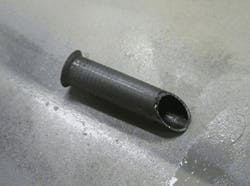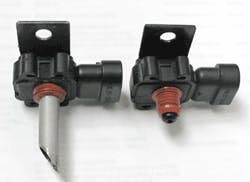As a field trainer, I sometimes pose in training classes the question, “Who here feels comfortable diagnosing late model diesel engines such as the GM Duramax?” I’m surprised at how many techs don’t hold up their hands confidently, even in a class full of techs specializing in diesels. It almost always turns out that the techs know a lot more than they realize in spite of their lack of rock solid confidence. If you’re one who feels the need to get your confidence built up a little more on dealing with the GM Duramax, this article will help you do just that.
Like This Article?
Check out related training at
Duramax Beginnings
When the 6600 Duramax came on the scene in 2001, the world changed for both gas and diesel techs. Developed for GM by Isuzu in a record 37 months, the engine began production in the Dayton, Ohio suburb of Moraine in 2000 for its debut in the 2001 model year 2500HD pickup. Diesel techs now found themselves up to their necks in a new and complex world of OBDII computerized engine management systems along with a new way of doing diesel injection – the common rail system. Starting out as the Regular Production Option (RPO), LB7 the engine had 300 hp and 520 foot-pounds of torque. The extra power resulted in GM coupling the engine to a new 5-speed 1000 series automatic transmission from Allison.
Also, a new technique of activating the direct injection made for a much quieter idle signature. Drivers who never would have considered purchasing a diesel pickup truck prior to the Duramax now were embracing this new engine. The Duramax caught the eye of the automotive press too receiving Ward’s Magazine “10 Best Engines in the World” award two years in a row.
The engine has seen some fairly radical changes in its 6600 format. From the LB7 in 2001-2004 came the 2004-2005 LLY replacement that advertised more power and 90 percent fewer HC and NOx emissions. Injector fuel feed lines were exposed, and it featured a new Garret variable displacement turbo, an electronic linear EGR valve with cooler and a host of other technical details such as new fast light off glow plugs and a new closed PCV system. The 2007-2011 LMM engines began including an oxidizing catalyst and the new diesel particulate filter (DPF) to reduce soot and particulate matter.
An electronically controlled throttle was added to aid in EGR operation and the DPF regeneration process. The 2011 to present LML engines began using 29,000 psi piezo injectors coupled with a complete fuel system-hardening to handle up to 20 percent biodiesel mixtures and urea injection. Urea helps with NOx reduction so trucks were equipped with a 5.3 gallon urea tank. This latest engine also has a fuel injector in the exhaust system to spray raw diesel fuel to aid in the PM filter regeneration.
Duramax Technical Foundations
Deep under the skin of a Duramax still is a diesel fuel burning, compression ignited and fuel throttled engine using glow plugs to heat the air on cold starts. But that’s about where the similarity ends.
During the past dozen years of the engine’s history, Duramax-equipped trucks, along with comparable models from Ford and Dodge, have gained even more popularity with owners, so gasoline drivability techs have joined in the ranks of diesel specialists diagnosing the light duty truck diesels. The Duramax is a 6.6 liter, 90 degree V8, direct-injection, overhead valve, four-valve-per-cylinder turbocharged engine with aluminum heads and a cast iron block. The electrically controlled common rail fuel system allows for full control of fuel injection timing and quantity. Just the right piston dome design coupled with a technique of starting just a little bit of injection first before shooting the full dose of fuel is the combination credited for the smooth and quiet idle factor.
Because diesels time their combustion events with fuel spray (as opposed to ignition timing on gas engines) you will see the “main injection event” following the pilot injection used at idle. As a general statement, it is important to note that not only will you see at least one pilot injection event prior to the main injection, you also might see an early post injection (for added torque) and even a late post injection on Selective Catalyst Reduction (SCR) equipped vehicles to aid in regeneration of the particulate filter.
The Lowdown on the Low Pressure
Duramax begins the high-pressure process with fuel from the tank the old fashioned way – suction from a pump up at the engine. In the gear-driven, high-pressure pump that creates the pressure for the common rail is a section of the pump that pulls fuel from the tank. If there is a problem getting that fuel, you’ll have low fuel pressure from the high-pressure pump and hard starts/no starts often will be the result. You can install a diesel low pressure/vacuum gage to determine which type of problem you have.
KD makes a gauge that has quick disconnect fittings to make testing easier. If air is being pulled into the low pressure side of the fuel supply system, you’ll see insufficient vacuum. If you see excessive vacuum, you have a restriction. Possible points for air are the lines from the tank to the Fuel Injection Control Module (FICM) fuel filter and water separator assembly and, of course, the pump itself. The place for possible restriction most likely is the filter.
Despite what GM says, you might want to follow a lot of experienced techs who believe it’s a good idea to replace the filter with each oil change due to issues with water contamination. The filter/water separator features a hand pump and bleeder screw to assist with priming the system and purging air for restarts in the event your customer runs out of fuel. Air getting in the system can cause misfires, stalling and hesitations on any common rail diesel engine.
Cranking Speed Vacuum 1 - 5 in. Hg
Idle Speed Vacuum 1 - 3 in. Hg
Hard Acceleration 6 - 10 in. Hg
3000 RPMs No Load 3 - 5 in. Hg
High Pressure – Really High Pressure
The same engine gear-driven pump that pulled fuel up from the tank next pressurizes the fuel to the common rail at pressures required for direct injection. Unlike earlier non-common rail diesels, this pump is not timed to the engine. The Duramax engine’s higher fuel pressure leads to a valuable point of caution.
hybrid electric vehicle voltages we’ve been taught to handle with caution. Refer to OE service information whenever servicing engine.
All the Duramax variations use a fuel return system between each injector, the high-pressure pump and the fuel tank. Early LB7 models were known for injector problem, and GM had to release a special policy No. 04039B extending free replacement out to seven years and 200,000 miles. Fuel injector body cracks, ball seat erosion and high pressure seal extrusion were experienced with these trucks. Hard starts, no starts, DTCs, fuel smells and diluted crankcases were the common complaints because of too great of return volume at the injectors or internal leakage at the injectors.
The FICM
Duramax injectors receive their 90-plus volts of DC courtesy of the FICM on earlier models and directly from the ECM on later versions (2007 and up). The FICM (or ECM) captures the first event of an injector coil’s inductive kick back when the injector has 12 volts applied. The kick back voltage from the injector coil collapsing its magnetic field is used to charge capacitors in the FICM. Those higher voltages stored in the FICM then can be applied back to the injectors to accomplish the injection event.
If an injector experiences an open or short circuit internally or within the wiring harness, the ECM shuts down an entire group of injectors that are related. When that happens, the FICM raises the injection volume for the other group of injectors to keep the engine running. Injector group pairings are the inner cylinders on one bank and the outer cylinders on the opposite bank. Injector electrical DTCs along with this grouping strategy means you are doubly sure that four cylinders on the same injector group circuit not firing means injector solenoid winding or injector wiring issues.
Injector Balancing Rates
The Duramax has misfire detection within the ECM via CKP and CMP inputs at idle. You can view on your scan tool the basic misfire counts or view injector balancing rates. The ECM detects if a cylinder needs more or less fuel to be balanced with the other injectors to provide smooth power contribution. Your target is zero, and that’s what you’ll see on a new set of injectors installed in a mechanically sound engine.
After the injectors have been in that engine a while, those numbers will vary. If an injector exceeds specs, there is a problem. View balancing rates for each injector with the engine idling above 180ºF for at least 30 seconds. Maximum specs are +/- 4 in park and +/- 6 in drive. One other important thing to remember is that misfire diagnostics may be suspended when the fuel level is very low.
A fuel rail pressure sensor measures the constantly fluctuating high pressure and is a scan tool PID giving you some very good information in your diagnostic routines. Another scan tool PID, desired fuel rail pressure, always should be very close to what the actual rail pressure reads via the rail pressure sensor, both during running and cranking conditions. A handy feature on most scan tools is live data plotting. Plotting Desired Fuel Pressure along with Actual Fuel Pressure is an excellent way of determining if a drivability problem is fuel related. If you have a no start/hard start complaint, always go to these two scan tool PIDs first.
High Pressure Fuel Lines/Fittings
The “plumbing” of the high-pressure systems on any high-pressure common rail diesel including the Duramax is picky about torque. Do not skip the proper torque spec and procedure thinking you’ll just get it as tight as possible without breaking fasteners or stripping threads. Before and after those “seat of the pants” torque methods are leaks from being just slightly too loose and damaged fittings from being just slightly too tight. Also, for safety’s sake do not try to snug a fitting while the engine is running. As mentioned previously, a leak at that pressure level can send fuel spraying like a CNC water cutting machine. For starting a Duramax, you’ll need a minimum of 1,500 psi fuel pressure at the rail while cranking and at idle a minimum of 5,000 psi.
Piezo Injectors
The 2010.5 model Duramax engines began using this new style of injector that uses several hundred piezo wafers (stacked) that expand in an applied electric field. The ECM grounds the control circuit and supplies up to 250 volts at 20 amps, creating the movement in the piezoelectric actuator module. In less than 1 microsecond, the actuator module acts directly on the amplifier module through a hydraulic connection, which in turn controls the valve group inside the injector. This gives more injection control than ever before.
Carbon, EGRs and Turbos
If you’ve ever worked on a Ford 6.0 PowerStroke, you already know all about EGR valve and EGR cooler issues. Soot is an age-old problem with diesels causing carbon buildup throughout the induction and exhaust systems. Without a throttle body (for throttling rpms that is) and all things equal, a diesel is a better breather than a gas engine.
All things equal starts to change drastically when the intake and exhaust passageways are not flowing like they once were. Crankcase vapors do contribute to this problem in addition to EGR. Blending exhaust gas back into the intake for the purpose of quenching combustion temperatures (courtesy the inert nature of exhaust) makes sense for a limiting NOx emissions, but can exasperate the issue of soot and carbon buildup. The turbocharger also can be a victim of carbon and soot deposits causing the vanes used for the variable geometry feature on later Duramax engines to stick.
There are two different failure modes of a glow plug: fast and slow. Fast failures involve an open circuit internal to the glow plug and no visible evidence of a problem. Slow failures involve an obvious missing or damaged tip of the plug along with an open circuit. Obviously, the head is going to have to come off if you’ve spotted a missing tip because it went somewhere into the cylinder. Always check for issues with the alternator output connection, battery cable connections, bussed electrical center connections and of course grounds. They all need to be in tip-top condition.
There are other electrical problems that can create an electrical noise issue that also can damage glow plugs. The damaging electrical noise might be induced by jump starting, disconnecting the batteries with the ignition in the ON position, or a battery charger being used during a module reprogramming event. Finally, you must ensure you have the correct glow plugs for the truck’s RPO code. Early LB7 models used a gold tipped glow plug while later models transitioned to a silver tipped glow plug that has a fast heat up characteristic to help with reduced emissions. To meet 2001 California emissions, a solid-state glow plug controller operated by the ECM had dominion over heating each cylinder separately. During a typical glow plug cycle, 110 amps of current is applied for 1.8 seconds, dropping to the 30 amps needed to maintain a tip temperature of 1,832 degrees F. Later model years using silver and earlier gold tipped glow plugs can't be interchanged. Popping in the older gold tips in a truck that requires the silver plugs will result in hard starting due to a lack of heat. Vice versa might result in glow plug failure and engine damage from glow plug shrapnel.
Hot Air and Calibration Updates
The Duramax 6600 uses a heating element in the intake manifold inlet for heating the air during cold starts. It supplements glow plugs, which all Duramax engines use. A couple of years of Duramax production saw the heater deleted. If your customer’s Duramax is equipped with a heater that doesn’t work, cold starting and drivability issues are possible. The purpose of the heater is to reduce the amount of white smoke on startup and after long downhill decelerations.
Speaking of white smoke on start-up, there are calibration updates available for the ECM that address a multitude of Duramax issues including the white smoke symptom. Due to the mid-year RPO changeovers you could have more than one choice of Duramax engine in a GM truck. A telltale tip for which engine you have is sometimes the shape of the air cleaner. Round or square air cleaner choices are listed in the GM calibration tables. Pay attention to which one you have before you flash an ECM and don’t flash an ECM for a white smoke issue noted in the calibration if you don’t have that issue with your customer’s truck.
For some unknown reason, many techs report this actually can have a reverse effect – causing white smoke that wasn’t present before. That doesn’t make sense to me but enough techs have reported this that I truly believe this to be the case. Keep in mind in addition to a thorough search for TSBs, always Google “GM CAL ID” early on in your diagnostic path even if you don’t personally do flashing at your shop. The free GM website that comes up in the search allows you to determine if there are any updates available (by VIN) to address a concern your customer may have. According to recent sources at GM, only about 50 percent of all calibration updates have a TSB to accompany them. That’s a very good reason to visit the GM CAL website to check for updates relevant to your customer’s complaints.
Finally, keep up your research on problems and solutions on the GM Duramax. There is tons of information out there on a broad range of topics ranging from turbo relearn procedures, how to handle issues with aftermarket power kits and the need for performing an injector flow rate programming procedure (called IQA on 2006 and later models) anytime the injectors, glow plug control module or ECM is changed. Your continued research will help you with your quest for learning all there is to know about Duramax service and that will keep your confidence level ratcheting upward.

